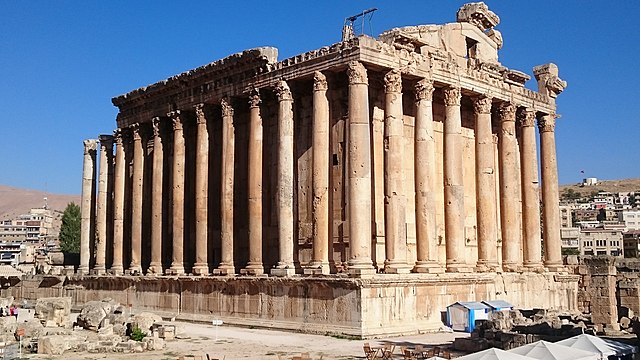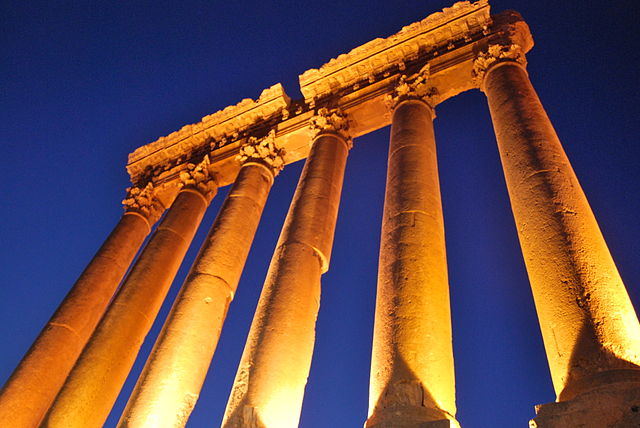Exploring the City of Baalbek

Photo: Wiki Commons
By: Clara Jude/Arab America Contributing Writer
Baalbek is one of the many gems Lebanon has to offer. The Romans also called it the City of the Sun because they believed it to be hit by the strongest sun in the world. Baalbek is located approximately 85 km northeast of Beirut in Lebanon’s Beqaa Valley. This is a city steeped in history.
Roman Ruins
One of the most iconic landmarks in Lebanon is the Roman Ruins in Baalbek. It encompasses the ruins of one of the largest Roman religious sites. The remaining structures are now a national emblem and attract thousands of pilgrims and tourists every year.
Originally, a site of Phoenician worship, the temples were taken over by the Romans after their colonization. What was once the home of Astarte became the home of Venus, the Goddess of Love. The same site also endured the Christian and Islamic eras to become what it is today.
Dominating the center of modern Baalbek, this wonderful Roman temple complex is one of the Middle East’s major archaeological highlights. The monumental Temple of Jupiter impresses by its sheer scale, while the adjacent Temple of Brucchas is astoundingly well preserved with exquisite carved decoration. The much smaller Temple of Venus is opposite the main entrance. In the summer, the ruins are the atmospheric venue for the Baalbeck International Festival (see below).
Stone of the Pregnant Woman
The Stone of the Pregnant Woman, also known as the Stone of the South, is another world wonder and must-see site. The largest ancient stone block was found by the Lebanese-German team of archeologists excavating in Baalbek. This block was most likely intended to be added to the temple complex 900 meters away. Archaeologists have examined the site and determined that it was left where it was due to the stone quality’s fragile nature. If moved, it would have been damaged and deemed unusable.
There are many stories behind the name. The most widely known and believed is that a pregnant woman told the people of Baalbek she knew how they could transport this stone. She would only tell them if they fed her until she gave birth. Another story states that women who touch this stone will have a higher chance of fertility and that is how it got its name.
Syeda Khawla Shrine
The shrine of Syeda Khawla, the daughter of Imam Hussein and great-granddaughter of Prophet Muhammad, is a religious attraction located at the southern entrance of the “City of the Sun.” If you’re interested in seeing majestic Arabesque architecture, which defines many countries in the Arab world, Sayeda Khawla Shrine is a good place to experience a taste. A site of reverence for Shia Muslims, the shrine is well-kept as her burial site is thought of as a source of blessing.
The striking mosque with its blue mosaic minarets and an interior filled with mirrored tiles and a gilded mausoleum is worth the trip alone. The story goes that Syeda Khawla was between a newborn and two years old when she accompanied the caravan of women and children taken from Karbala to Damascus. She died en route in Baalbek and was buried there by her brother, Imam Zainul Abideen. A cypress tree was planted beside her grave.
Three hundred years ago, Syeda Khawla spoke to a member of the Moqtada family in a dream, asking him to divert a stream away from her deceased body. This dream reoccurred several times. This led the family to excavate the site and relocate her grave. A small shrine was then built at that location in her honor. The breathtaking shrine and mosque were built over this site in 2005. The original cypress tree is still intact.
Sfiha Baalbakiye
This is meat mixture is a combination of ground lamb or beef with onion, parsley, tomatoes, a dash of chili pepper, pomegranate molasses, labneh, and a bit of tahini. The meat mixture is uncooked and baked with the dough.
Lakkis Restaurant is a farm-to-table restaurant in Baalbek that is renowned for its Sfihas. It is prepared in the restaurant from the meat to the dough
Baalbek International Festival

Photo: Wiki Commons
The Baalbeck International Festival is the oldest and most prestigious cultural event in the Middle East. It was founded in 1956 and managed by twelve members. The Festival has now become an annual event that takes place from early July to the end of August. The festival which takes place in the magnificent ruins of the Bacchus and Jupiter temples has produced many world-class plays, Lebanese nights, operas, classical music, pop and jazz concerts, modern and classical dance, and lyric songs world premieres.
The primary sources of funding for this event are the Ministry of Tourism, the private sector, and ticketing. The mission of the Baalbeck International Festival is to promulgate the cultural and touristic life of the country and nurture the most enticing artistic environment of cross-cultural exchange. In addition, it provides the settings for the performance of innovative works by local and regional artists, as well as acclaimed international performers.
The main objective is to maintain its mission despite the difficult situation in Lebanon and the region and give a message of hope and life to the Lebanese people.



